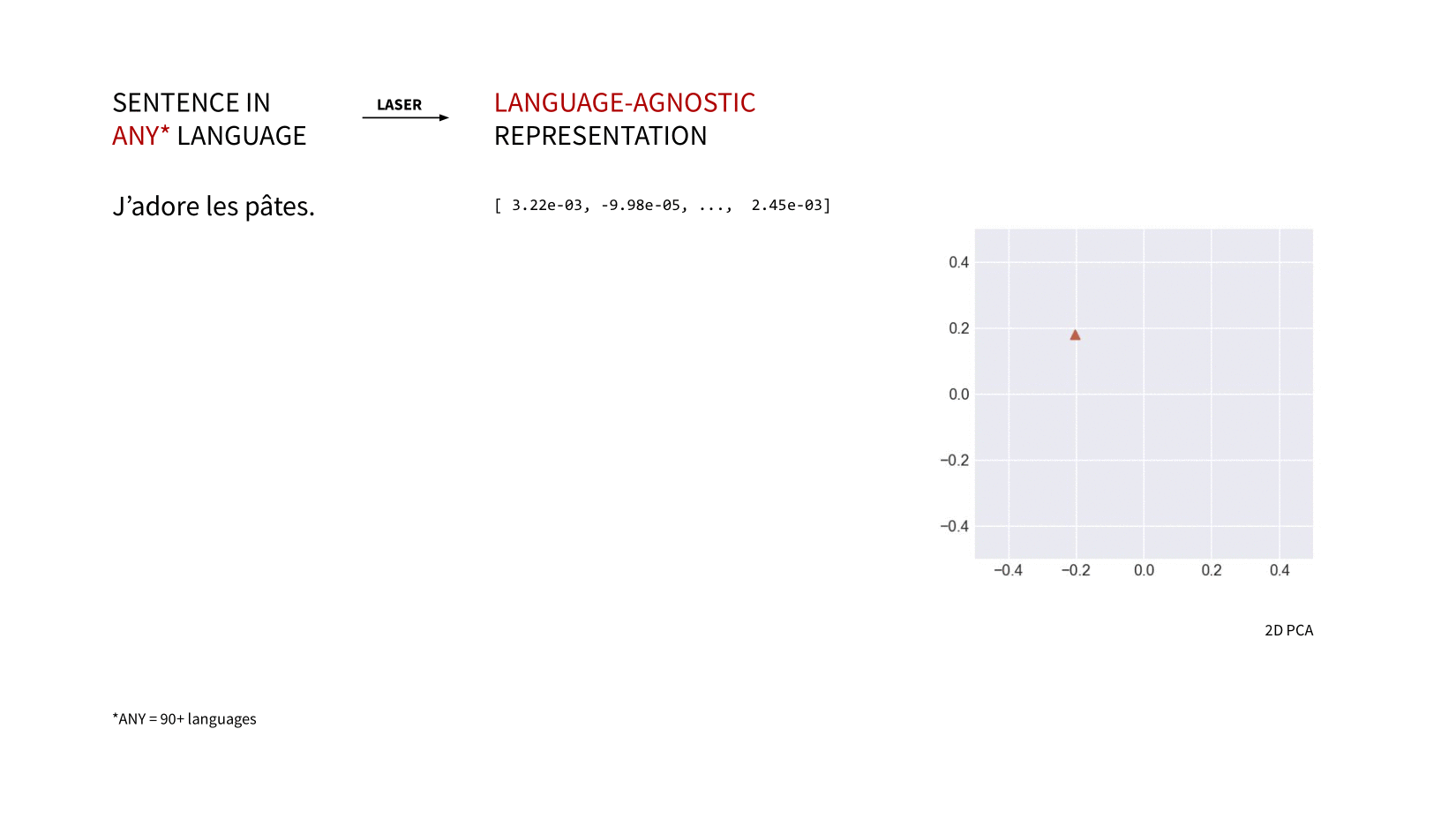Out-of-the-box multilingual sentence embeddings.
laserembeddings is a pip-packaged, production-ready port of Facebook Research's LASER (Language-Agnostic SEntence Representations) to compute multilingual sentence embeddings.
✨ Version 1.1.2 is here! What's new?
- A compatibility issue with subword-nmt 0.3.8 was fixed (#39) 🐛
- The behavior of
Laser.embed_sentenceswas unclear/misleading when the number of language codes received in thelangargument did not match the number of sentences to encode. It now raises an error in that case 🐛
LASER is a collection of scripts and models created by Facebook Research to compute multilingual sentence embeddings for zero-shot cross-lingual transfer.
What does it mean? LASER is able to transform sentences into language-independent vectors. Similar sentences get mapped to close vectors (in terms of cosine distance), regardless of the input language.
That is great, especially if you don't have training sets for the language(s) you want to process: you can build a classifier on top of LASER embeddings, train it on whatever language(s) you have in your training data, and let it classify texts in any language.
The aim of the package is to make LASER as easy-to-use and easy-to-deploy as possible: zero-config, production-ready, etc., just a two-liner to install.
👉 👉 👉 For detailed information, have a look at the amazing LASER repository, read its presentation article and its research paper. 👈 👈 👈
You'll need Python 3.6+ and PyTorch. Please refer to PyTorch installation instructions.
pip install laserembeddings
Chinese is not supported by default. If you need to embed Chinese sentences, please install laserembeddings with the "zh" extra. This extra includes jieba.
pip install laserembeddings[zh]
Japanese is not supported by default. If you need to embed Japanese sentences, please install laserembeddings with the "ja" extra. This extra includes mecab-python3 and the ipadic dictionary, which is used in the original LASER project.
If you have issues running laserembeddings on Japanese sentences, please refer to mecab-python3 documentation for troubleshooting.
pip install laserembeddings[ja]
python -m laserembeddings download-models
This will download the models to the default data directory next to the source code of the package. Use python -m laserembeddings download-models path/to/model/directory to download the models to a specific location.
from laserembeddings import Laser
laser = Laser()
# if all sentences are in the same language:
embeddings = laser.embed_sentences(
['let your neural network be polyglot',
'use multilingual embeddings!'],
lang='en') # lang is only used for tokenization
# embeddings is a N*1024 (N = number of sentences) NumPy arrayIf the sentences are not in the same language, you can pass a list of language codes:
embeddings = laser.embed_sentences(
['I love pasta.',
"J'adore les pâtes.",
'Ich liebe Pasta.'],
lang=['en', 'fr', 'de'])If you downloaded the models into a specific directory:
from laserembeddings import Laser
path_to_bpe_codes = ...
path_to_bpe_vocab = ...
path_to_encoder = ...
laser = Laser(path_to_bpe_codes, path_to_bpe_vocab, path_to_encoder)
# you can also supply file objects instead of file pathsIf you want to pull the models from S3:
from io import BytesIO, StringIO
from laserembeddings import Laser
import boto3
s3 = boto3.resource('s3')
MODELS_BUCKET = ...
f_bpe_codes = StringIO(s3.Object(MODELS_BUCKET, 'path_to_bpe_codes.fcodes').get()['Body'].read().decode('utf-8'))
f_bpe_vocab = StringIO(s3.Object(MODELS_BUCKET, 'path_to_bpe_vocabulary.fvocab').get()['Body'].read().decode('utf-8'))
f_encoder = BytesIO(s3.Object(MODELS_BUCKET, 'path_to_encoder.pt').get()['Body'].read())
laser = Laser(f_bpe_codes, f_bpe_vocab, f_encoder)Some dependencies of the original project have been replaced with pure-python dependencies, to make this package easy to install and deploy.
Here's a summary of the differences:
| Part of the pipeline | LASER dependency (original project) | laserembeddings dependency (this package) | Reason |
|---|---|---|---|
| Normalization / tokenization | Moses | Sacremoses 0.0.35, which seems to be the closest version to the Moses version used to train the model | Moses is implemented in Perl |
| BPE encoding | fastBPE | subword-nmt | fastBPE cannot be installed via pip and requires compiling C++ code |
| Japanese segmentation (optional) | MeCab / JapaneseTokenizer | mecab-python3 and ipadic dictionary | mecab-python3 comes with wheels for major platforms (no compilation needed) |
For most languages, in most of the cases, yes.
Some slight (and not so slight 🙄) differences exist for some languages due to differences in the implementation of the Tokenizer.
An exhaustive comparison of the embeddings generated with LASER and laserembeddings is automatically generated and will be updated for each new release.
How can I train the encoder?
You can't. LASER models are pre-trained and do not need to be fine-tuned. The embeddings are generic and perform well without fine-tuning. See facebookresearch/LASER#3 (comment).
Thanks a lot to the creators of LASER for open-sourcing the code of LASER and releasing the pre-trained models. All the kudos should go to them 👏.
A big thanks to the creators of Sacremoses and Subword Neural Machine Translation for their great packages.
The first thing you'll need is Poetry. Please refer to the installation guidelines.
Clone this repository and install the project:
poetry install -E zh -E ja
To run the tests:
poetry run pytest
First, install the project with the extra dependencies (Chinese and Japanese support):
poetry install -E zh -E ja
Then, download the test data:
poetry run python -m laserembeddings download-test-data
👉 If you want to know more about the contents and the generation of the test data, check out the laserembeddings-test-data repository.
Then, run the test with SIMILARITY_TEST env. variable set to 1.
SIMILARITY_TEST=1 poetry run pytest tests/test_laser.py
Now, have a coffee ☕️ and wait for the test to finish.
The similarity report will be generated here: tests/report/comparison-with-LASER.md.




